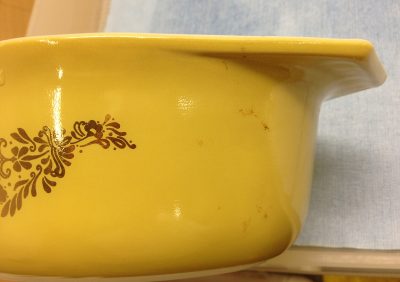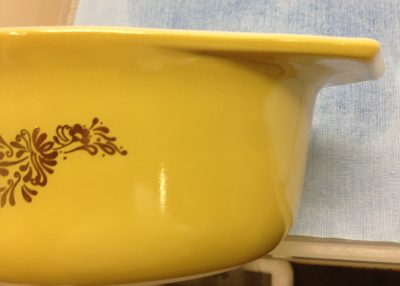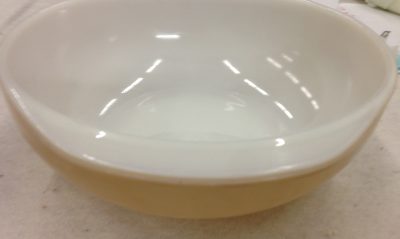Stephen Koob is the chief conservator at The Corning Museum of Glass and is responsible for the care and preservation of the Museum’s collections.
Editor’s note: Stephen Koob works in a lab where he takes seriously all safety precautions when dealing with chemicals. Please note that we strongly recommend using the precautions noted below before using lye. Should you experience any adverse effects, please contact your local Poison Control for information.

Cleaning your beloved Pyrex — whether clear, colored, decorated, or plain — can be a challenge and should be done with care.
First, never, ever put any Pyrex through a dishwasher. This is the fastest and most damaging thing that you can do. It will slowly etch the Pyrex, and probably will not even do a decent job cleaning it. I generally recommend that you never put any glass through a dishwasher.
Second, never use any scrubbing sponge, even if it says “safe for glass,” or “non-scratch.” This includes wire wool cleaning pads.
Also avoid using sharp implements to clean off caked-on or burnt food. Glass can easily be scratched.
So, what do you use?
Start with warm or hot water and a soft sponge or cotton towel. Use a clear detergent, preferably without perfume. There are several, readily available clear detergents made for cleaning dishes. You do not need to use a green or orange detergent. The green or orange colors are dyes, and you do not need that in contact with your Pyrex. You also do not need it to smell like perfume (which is simply another chemical, of unknown type).
Wipe all the surfaces, rinse, and examine. If it is not clean, soak it in the sink or a plastic tub with hot soapy water, for an hour, or overnight. Repeat the cleaning process. If this works, rinse, gently towel-dry, and you’re done. If this doesn’t work, read on.
Cleaning stubborn stains off of Pyrex is actually simple, fast, and inexpensive, but requires some careful set-up, and some very important safety procedures. These procedures must be followed, even though my mother and most housewives from the 1950s and ‘60s used what I am going to recommend without any safety precautions. But times have changed, and there are some risk issues, and I want to protect you from those risks.
Lye
You need to use a very well-known cleaning agent, which my mother and probably most households had right under their kitchen sink. It is called “lye.” You can Google this and read up on it; it is still produced under the name of “Red Devil Lye,” or “Duda’s Red Hot Devil Lye.” Do not use oven cleaner or other materials that simply contain lye. Go to the original.
Lye is sodium hydroxide and is a very strong alkali (or base). In high concentrations, it is dangerous and can cause serious burns. In dilute (lower) concentrations it can also cause irritation and, with prolonged contact, burns.
So you need the following: rubber gloves, some plastic goggles, a plastic tub, maybe some cotton balls (or a roll of cotton), and some simple plastic brushes (a very soft toothbrush is ideal), maybe a plastic apron. Do not use natural hair brushes of any type because the lye will dissolve them. Nylon paint brushes are fine.
Put on your gloves and goggles (and apron) before mixing. You want to use approximately a 10% solution of lye, dissolved in water. This is about two teaspoons of lye in a small juice glass (about six ounces) of water. If you have bought the liquid lye, check to see what its concentration is, and dilute it (using your favorite Pyrex glass measuring cup, of course!). If it is a 50% concentration, you can add one ounce to about four or five ounces of water. It does not have to be absolutely precise. But again, be careful. You should always add the chemical to the water and not add water to the chemical. This is true for liquid lye or crystal lye or pellets of lye. Add the lye to the water and stir until it is dissolved. This will take a few minutes; do not stand over it breathing in the fumes. You will notice that the solution gets hot. That is simply the chemical reaction of the lye mixing with the water. You do not have to use it hot, and what you do not use, you can save for later use.
Put your stained Pyrex dish in the tub. Dip your brush into the dilute lye and apply it to the stains on the Pyrex. Light stains will almost instantly dissolve, evidenced by brownish drips down the side. Heavier stains, such as caked-on casserole, burnt meat, or pie crust may require a second or third application. In between every cleaning, lift the Pyrex dish out of the plastic tub and rinse it with warm water. This way you can evaluate the cleaning process. You rarely need to have the lye on the dish for more than 20 to 30 seconds.
- Pyrex surface before cleaning.
- Pyrex surface after cleaning.
Deep, serious cleaning may require some soaking or cotton compresses, wetted with the lye solution. In general, these stains get trapped in the “PYREX” lettering on the bottom of the glass pie dish or Pyrex bowl, on the scallops of a pie dish, or the edges of a bowl or casserole rim. Again, this cleaning should always be done in the plastic tub, gently pouring the lye solution onto the cotton or around the rim (of a pie plate or casserole dish). Leave it on for two to three minutes, remove and brush as before, rinse. Repeat, if necessary.
- Edge of handle before cleaning.
- Edge of handle after cleaning.
I have yet to see a stain or food residue that this did not work on, and I have never seen the lye change the color of a Pyrex dish, or damage the glass. It will reveal if the glass has been over-cleaned, because, once you get all the stains off, scratches and damage from previous cleaning will be easy to see.
Rinse your Pyrex dish at the end. Towel dry with a soft cotton towel. Rinse your gloves, tub, brushes, etc., and store them away for next time. Save the diluted lye in a plastic bottle. Label it and keep it out of children’s reach.
Damaged Pyrex, primarily from over-cleaning, cannot be fixed. There is no way to safely re-polish Pyrex, or recoat it.
Final precautions
- If by accident you spill some lye on your clothes, shoes, or bare skin, rinse it off immediately with water.
- Avoid getting lye on anything wooden or aluminum. It will darken (burn) wood, and slightly etch aluminum.
- Avoid breathing the fumes. This is why lye was generally discontinued as an oven cleaner. It’s as bad as getting a whiff of ammonia.
- If you would prefer to dispose of the diluted lye, we recommend contacting your local water treatment plant or waste management company for instructions on disposing of hazardous materials.







34 comments » Write a comment